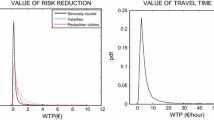Abstract
This article is concerned with the possible role of reference points and loss aversion (as suggested by prospect theory) in subjects' judgments about the value of increments and decrements in automobile safety. The contingent valuation method is employed in two experiments, both of which consider subjects' willingness-to-pay (WTP) for increased safety and compensation demanded (CD) for decreased safety in hypothetical new vehicle purchases. The results establish that disparities exist in subjects' WTP and CD values for the same increment of auto safety, even for a close-to-market context such as hypothetical new vehicle purchases. The results also indicate that evaluations can be manipulated by changing the perception of the reference point: losses can be recast as forgone gains and forgone gains as losses, altering (or even eliminating) differences between WTP and CD values.
Similar content being viewed by others
References
Fischhoff, B. and L., Furby. (1988). “Measuring Values: A Conceptual Framework for Interpreting Transactions with Special Reference to Contingent Valuation of Visibility,” Journal of Risk and Uncertainty 1, 147–188.
Fisher, A., G. H., McClelland, and W. D., Schulze. (1989). “Measures of Willingness-to-Pay versus Willingness-to-Accept: Evidence, Explanations, and Potential Reconciliation.” In G. L., Peterson, B. L., Driver, and R., Gregory (eds.), Amenity Resource Valuation: Integrating Economics with Other Disciplines. State College, PA: Vonture Publishing, pp. 127–133.
Jones-Lee, M. W., M., Hammerton, and P. R., Phillips. (1985). “The Value of Safety: Results of a National Sample Survey,” The Economic Journal 95, 49–72.
Kahneman, D. and A., Tversky. (1979). “Prospect Theory: An Analysis of Decision under Risk,” Econometrica 47, 263–291.
Knetsch, J. L. and J. A., Sinden. (1984). “Willingness to Pay and Compensation Demanded: Experimental Evidence of an Unexpected Disparity in Measures of Value,” Quarterly Journal of Economics 99, 507–521.
McDaniels, T., M. Kamlet, and G. Fischer. (1989). “Risk perception and the value of safety,” unpublished manuscript, Carnegie Mellon University (available from the author).
Mitchell, R. C. and R. T., Carson. (1989). Using Surveys to Value Public Goods: The Contingent Valuation Method. Washington, DC: Resources for the Future.
Thaler, R. (1980). “Toward a Positive Theory of Consumer Choice,” Journal of Economic Behavior and Organization 1, 39–60.
Thaler, R. and E., Johnson. (1990). “Gambling with the House Money and Trying to Break Even: Effects of Prior Outcomes on Risky Choice,” Management Science 36(6), 643–660.
Tversky, A. and D., Kahneman. (1981). “The Framing of Decisions and the Psychology of Choice,” Science 211, 453–458.
Viscusi, W. K., W., Magat, and P., Huber. (1987). “An Investigation of the Rationality of Consumer Valuations of Multiple Health Risks,” Rand Journal of Economics, 18, 465–479.
Willig, R. D. (1976). “Consumers' Surplus without Apology,” American Economic Review 66, 589–597.
Author information
Authors and Affiliations
Additional information
I would like to thank Mark Kamlet, Greg Fischer, and Granger Morgan for advice and help in structuring the research for the first experiment; Paul Slovic and Jack Knetsch for suggestions regarding the structure and content of the second experiment; Robin Gregory and two anonymous referees for insightful comments on earlier drafts; and the subjects who provided their time in the two experiments. Michael McNickle provided able research assistance for the second experiment. The survey for the first experiment was partially supported by the Program for Technology and Society at Carnegie Mellon University, with funds from the Andrew W. Mellon Foundation.
Rights and permissions
About this article
Cite this article
Mcdaniels, T.L. Reference points, loss aversion, and contingent values for auto safety. J Risk Uncertainty 5, 187–200 (1992). https://doi.org/10.1007/BF00057571
Issue Date:
DOI: https://doi.org/10.1007/BF00057571




